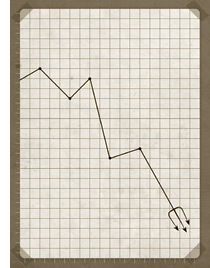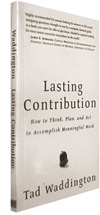Books in Brief
Why financial markets are brittle, companies stop growing, Ryanair took off, and plans succeed or fail.
(originally published by Booz & Company)|
A Demon of Our Own Design: Markets, Hedge Funds, and the Perils of Financial Innovation By Richard Bookstaber John Wiley & Sons, 2007, 288 pages
In 2005, Alan Greenspan observed that “increasingly complex financial instruments have contributed to the development of a far more flexible, efficient, and hence resilient financial system than the one that existed just a quarter-century ago.” Richard Bookstaber disagrees. In A Demon of Our Own Design: Markets, Hedge Funds, and the Perils of Financial Innovation, Bookstaber, who is a portfolio manager with FrontPoint Quantitative Fund, uses a thoroughly systematic approach to show us how financial disasters like the sudden collapse of Bear Stearns are bound to happen. Although the U.S. economy appears to be flexible and resilient enough to weather most financial crises, in Bookstaber’s view the financial markets are increasingly brittle. This makes them vulnerable to shocks that can sweep through the system like wildfire through a parched forest. With 10 years’ experience at Morgan Stanley and another eight at Salomon Brothers, Bookstaber was placed close to the epicenters of earlier disasters, notably the market crash of 1987 and the failure of Long-Term Capital Management in 1998. He also observed firsthand the evaporation of Salomon Brothers’ business after it was acquired by Travelers Group in 1997 before being folded into Citibank. He takes us through all these events, deftly interweaving stories and systems concepts as he teases out the underlying threads. Financial market complexity, Bookstaber says, cloaks catastrophe. He traces the life cycle of that complexity. Because their traditional business activities have been priced like commodities, all the players in the investment community have had to move up-market, either by developing relationship-type businesses like investment banking or by continually coming up with new financial products that may offer superior returns for a short period before others copy them. These innovations, Bookstaber suggests, are a double-edged sword: They improve market efficiency, but they also add risks that cannot be foreseen and therefore cannot be mitigated. There’s a more subtle underlying problem: Although the general public may have enormous faith in the ability of the marketplace to allocate resources, this faith is based on assumptions about market efficiency that work well only in theory. Real markets in a granular world of space, time, and human beings behave differently. Economists insist on maximizing the transparency of information to all players in the market, when the real problem is a lack of liquidity and an excess of leverage. The constant innovation in financial instruments since the 1980s has made it difficult to see the funda-mental dynamics. The author points out that portfolio insurance, first developed in the 1980s, was really a sophisticated hedging strategy. But for it to work effectively, the markets had to be liquid. The word insurance was a great marketing hook, but it was a misnomer — there was no insurance company standing behind the portfolio, ready to step in if anything went wrong.
Efficiency and resiliency, far from being complementary, contradict each other; improvements in one variable may lead to deterioration in the other. The wrong kind of regulation may exacerbate this vicious dynamic. Bookstaber believes that regulations should aim at reducing complexity in the first place, rather than trying to control it after the fact, even if this means slowing the rate of innovation. It seems that we are indeed the architects of our own misfortune.
|
|
Stall Points: Most Companies Stop Growing — Yours Doesn’t Have To By Matthew S. Olson and Derek Van Bever Yale University Press, 2008, 256 pages
Within the “strategic” category of root causes, Premium Position Captivity is the most prevalent (responsible for 23 percent of stalled growth at companies), and it is a situation that will be familiar to readers of Clayton Christensen’s work on disruptive innovation. Seeking higher margins and less price sensitivity, firms migrate up-market with their product offerings, trying to offer unique functionality. Here they become vulnerable to attacks by low-cost disruptors offering less functionality but rock-bottom prices. Next in these strategic categories is Innovation Management Breakdown (13 percent), Premature Core Abandonment (10 percent), Failed Acquisition (7 percent), and so on, to make seven strategic categories in all. The authors then break down most of these into subclasses. Of course, the concept of a root cause analysis, as practiced by the quality movement, is not meaningful in an aggregate sample of 50 firms, and the so-called root causes are really categories of causes that demand further examination. The authors recognize this and provide several practice briefs for articulating and testing assumptions as well as a “red flag” self-test for management that may give warnings of an impending stall. All these make eminent sense, and the analytical framework seems sound. But one has to wonder how it is that nearly 90 percent of Fortune 100 companies experience a stall (as the authors’ analysis shows) if the vast majority of the causes are under management control. Charges of widespread complacency and incompetence, often made by people other than these authors, are not credible. It seems more likely that if a true root cause analysis were done, business unit by business unit, the causes would prove to be far more complex and intractable than suggested by the analysis in this book. Whether or not you see organizational decline as inevitable depends very much on where you stand. Management academics who take a long, detached view can argue persuasively that nature does not rely on large trees to reinvent themselves but destroys them and recycles their components. Saplings are nourished so that the forest is renewed. Those closer to the action and with shorter time frames cannot afford the luxury of this view. A.G. Lafley, CEO of Procter & Gamble, reportedly tells his staff that he does not believe in the existence of the product life cycle. P&G’s leaders have to revitalize their product offerings every day, never considering the probability of their demise. Thus they have extended the lives of their products in ways that have astonished outsiders. The Swiffer, which revolutionized the humble task of mopping, is just one example. This book’s message is a timely reminder to all managers of this potential for renewal.
|
|
Michael O’Leary: A Life in Full Flight: The Story of the Man Who Made Ryanair Take Off By Alan Ruddock Penguin Ireland (available through specialty retailers), 2007, 448 pages
O’Leary and the Ryanair business model fit the principles of crude Darwinism and neoclassical economics perfectly. It’s all about survival of the fittest and the practice of a selfish rationality that, according to modern economics, makes up the invisible hand of free markets. O’Leary is fanatical about cutting costs; air crew who are looking for jobs have to pay for their interviews with Ryanair and fund their own training and uniforms if they are accepted. Head office staff must supply their own pens and are forbidden to charge their cell phones at work. O’Leary has no passion for the airline business at all. What turns him on, apparently literally, is making money. After keeping a convenience store he owned open one Christmas Day and making a bundle, he said, “I have never had a sexual experience in my life like it. The feeling of having one wad of notes pushed down one side of my trousers and another wad of notes down the other….” A manager with a business model like Ryanair’s can learn very little from a business book. The company’s “pile it high, sell it cheap,” point-to-point flight strategy, borrowed from Southwest Airlines, is as old as commerce and works wonderfully well — for Ryanair. Its customers, 99 percent of whom book their fares online, regard air travel as a commodity and are prepared to live with all kinds of inconvenience to get the deals Ryanair offers. The managerial innovations are not in the strategy but in the details of its implementation in the specific context of a point-to-point airline operating in Europe. O'Leary has proved a master at extracting fees from European regional airports desperate to build their local economies. Ryanair’s competitors are mostly national legacy carriers constrained by onerous labor agreements with militant unions, expensive aircraft, huge infrastructures, and obligations that they cannot abandon unless entering into bankruptcy. After the deregulation of European air travel, competitors can do very little against Ryanair; Michael O’Leary relishes thumbing his nose at them and everyone else.
|
|
Lasting Contribution: How to Think, Plan, and Act to Accomplish Meaningful Work By Tad Waddington Agate Publishing, 2007, 128 pages
Waddington has an interesting academic background, including a Ph.D. in measurement, evaluation, and statistical analysis and a master’s degree in the history of Chinese religions. His book is a short, lively meditation on thought and action that you can either read from start to finish or dip into by using the comprehensive index or glossary, or by choosing from a set of provocative questions he calls koans (after the paradoxical statements that Zen masters pose to their students). The basic organizing structure consists of the four causes — what has to be done (efficient cause), the resources needed (material cause), the design or plan (formal cause), and the reason (final cause). Nothing revolutionary here, although it’s surprising how often corporate plans seem to skip the first and the last and focus only on the second and the third. Within each of these headings, however, the author conducts a thoughtful exploration of what the concepts mean in the context of a complex system. In the process, he summons a wide range of insights drawn from eclectic sources: The Little Engine That Could puffs along happily with philosophers Hans-Georg Gadamer and Bertrand Russell. The bottom line, to paraphrase from the summary of the last chapter, is: You can make a lasting contribution to the world if you pursue a worthy goal, master your resources, have a plan for maximizing your efficacy, take sophisticated action, and coordinate the four causes so they work together. Stephen Covey says something similar using seven points but, as Tad Waddington proves, Aristotle did it long ago in only four. |
Reprint No. 08311
Author profile:
David K. Hurst is a contributing editor at strategy+business. His writing has also appeared in the Harvard Business Review, the Financial Times, and other leading business publications. Hurst is the author of Crisis and Renewal: Meeting the Challenge of Organizational Change (Harvard Business School Press, 2002).



 Fast, complex systems that are tightly entwined can go into runaway mode. Bookstaber argues, for example, that the 1987 stock market crash occurred simply because the fast-paced futures market was more liquid than the slower-cycling market for stocks. When futures dropped sharply, arbitragers transmitted that decline to the stock market. Instead of lower prices being interpreted as a signal to buy, they were seen as a warning that bad news was coming. As a result, liquidity suppliers were paralyzed just when they should have acted. Prices fell precipitously, triggering more programmed selling. At these times, when markets morph into what the author, using an analogy from physics, calls a “plasma” of undifferentiated assets, long-standing, stable relationships among financial indices are disrupted. With these stable relationships broken, the assumptions that underpin the multiple computer models being used to track markets become invalid. The game flips suddenly from probability-based roulette to psychology-based poker, offering huge profits to those brave enough to step up to the challenge but causing disaster for others.
Fast, complex systems that are tightly entwined can go into runaway mode. Bookstaber argues, for example, that the 1987 stock market crash occurred simply because the fast-paced futures market was more liquid than the slower-cycling market for stocks. When futures dropped sharply, arbitragers transmitted that decline to the stock market. Instead of lower prices being interpreted as a signal to buy, they were seen as a warning that bad news was coming. As a result, liquidity suppliers were paralyzed just when they should have acted. Prices fell precipitously, triggering more programmed selling. At these times, when markets morph into what the author, using an analogy from physics, calls a “plasma” of undifferentiated assets, long-standing, stable relationships among financial indices are disrupted. With these stable relationships broken, the assumptions that underpin the multiple computer models being used to track markets become invalid. The game flips suddenly from probability-based roulette to psychology-based poker, offering huge profits to those brave enough to step up to the challenge but causing disaster for others.  Nothing in nature grows to the sky, and in the corporate world, growth can stall for a multitude of reasons, many of which are under the control of the corporation’s management. At least that’s the diagnosis of Matthew S. Olson and Derek Van Bever, executive director and chief research officer, respectively, of the Corporate Executive Board, a worldwide network of executives from large organizations in the public and private sectors. In Stall Points: Most Companies Stop Growing — Yours Doesn’t Have To, they identify 42 root causes of stalled growth in large corporations. The authors estimate that only 13 percent (by frequency of occurrence) of these causes are outside the control of the corporate executives and that a whopping 70 percent fall under the rubric of “strategy.” The balance (17 percent) of root causes can be attributed to “organizational factors,” which are also seen as controllable by managers.
Nothing in nature grows to the sky, and in the corporate world, growth can stall for a multitude of reasons, many of which are under the control of the corporation’s management. At least that’s the diagnosis of Matthew S. Olson and Derek Van Bever, executive director and chief research officer, respectively, of the Corporate Executive Board, a worldwide network of executives from large organizations in the public and private sectors. In Stall Points: Most Companies Stop Growing — Yours Doesn’t Have To, they identify 42 root causes of stalled growth in large corporations. The authors estimate that only 13 percent (by frequency of occurrence) of these causes are outside the control of the corporate executives and that a whopping 70 percent fall under the rubric of “strategy.” The balance (17 percent) of root causes can be attributed to “organizational factors,” which are also seen as controllable by managers. “Business books are...usually written by wankers.” So says Michael O’Leary, CEO of Ryanair, one of the world’s largest and most successful international airlines. So it’s not surprising that he did not cooperate with journalist Alan Ruddock, who wrote this highly entertaining story about O’Leary and his company. The book’s title makes it sound like a biography, but it’s really the story of how O’Leary built Ryanair into a powerhouse adored by its customers and feared by its competitors. No matter. The biography of the company and the biography of the man are essentially the same: Since he joined the foundering airline in 1988 as the watchdog for its owner, legendary Irish businessman Tony Ryan, it’s not clear that O’Leary has had a life outside the company.
“Business books are...usually written by wankers.” So says Michael O’Leary, CEO of Ryanair, one of the world’s largest and most successful international airlines. So it’s not surprising that he did not cooperate with journalist Alan Ruddock, who wrote this highly entertaining story about O’Leary and his company. The book’s title makes it sound like a biography, but it’s really the story of how O’Leary built Ryanair into a powerhouse adored by its customers and feared by its competitors. No matter. The biography of the company and the biography of the man are essentially the same: Since he joined the foundering airline in 1988 as the watchdog for its owner, legendary Irish businessman Tony Ryan, it’s not clear that O’Leary has had a life outside the company. Systems thinking is “in” these days. After years of teaching students how to think analytically, many business schools are casting around to find ways of teaching students of management to think more holistically or systemically. Experts in several fields have suggested that one of the best ways to understand cause and effect in complex systems is to go all the way back to Aristotle and his four causes, or “explanatory factors.” Tad Waddington, director of performance measurement at Accenture, has written a new, highbrow self-help book, Lasting Contribution: How to Think, Plan, and Act to Accomplish Meaningful Work, using Aristotle’s four explanatory factors as the organizing framework.
Systems thinking is “in” these days. After years of teaching students how to think analytically, many business schools are casting around to find ways of teaching students of management to think more holistically or systemically. Experts in several fields have suggested that one of the best ways to understand cause and effect in complex systems is to go all the way back to Aristotle and his four causes, or “explanatory factors.” Tad Waddington, director of performance measurement at Accenture, has written a new, highbrow self-help book, Lasting Contribution: How to Think, Plan, and Act to Accomplish Meaningful Work, using Aristotle’s four explanatory factors as the organizing framework.